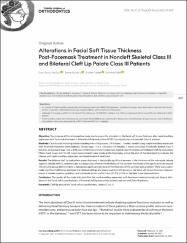| dc.contributor.author | Ulusoy Mutluol, Esra | |
| dc.contributor.author | Koyuncu, Sema | |
| dc.contributor.author | Ceylan, Rıdvan | |
| dc.contributor.author | Akın, Mehmet | |
| dc.date.accessioned | 2023-06-22T11:35:18Z | |
| dc.date.available | 2023-06-22T11:35:18Z | |
| dc.date.issued | 2022 | en_US |
| dc.identifier.uri | https://search.trdizin.gov.tr/tr/yayin/detay/1135215/alterations-in-facial-soft-tissue-thickness-post-facemask-treatment-in-noncleft-skeletal-class-iii-and-bilateral-cleft-lip-palate-class-iii-patients | |
| dc.identifier.uri | https://hdl.handle.net/20.500.12868/2291 | |
| dc.description.abstract | Objective: The purpose of this retrospective study was to assess the alteration in the facial soft tissue thickness after rapid maxillary expansion with facemask treatment in bilateral cleft lip and palate (BCLP) Class III patients and noncleft Class III patients. Methods: Case records including lateral cephalograms of 30 patients (19 females, 11 males) treated using a rapid maxillary expansion with facemask treatment were analyzed. Group I (age: 11.4 ± 1.02 years) (10 females, 5 males) consisted of noncleft skeletal Class III patients, and group II (age: 10.8 ± 0.84 years) (9 females, 6 males) comprised skeletal Class III patients with bilateral cleft lip and palate. Fifteen hard tissue and 10 soft tissue measurements were made at the beginning and at the end of the treatment to evaluate the change with rapid maxillary expansion combined facemask treatment. Results: The bilateral cleft lip and palate group displayed a statistically significant increase in the thickness of the subnasale, labrale superius, labrale inferius, labiomentale, and pogonion, whereas the thickness of the stomion was found to be significantly decreased. The noncleft group demonstrated a statistically significant decrease in the thickness of the stomion and gnathion. There was a statistically significant difference between the bilateral cleft lip and palate and noncleft groups in the facial soft tissue thickness measurements at labrale superius, gnathion, and subnasale points and in Y axis, U1-SN, U1-NA in the hard tissue measurements. Conclusion: The results of the study indicated that the rapid maxillary expansion with facemask treatment produced diverse alterations in the facial soft tissue thickness of bilateral cleft lip and palate patients and noncleft Class III patients | en_US |
| dc.language.iso | eng | en_US |
| dc.relation.isversionof | 10.5152/TurkJOrthod.2022.21164 | en_US |
| dc.rights | info:eu-repo/semantics/openAccess | en_US |
| dc.subject | Cleft Lip and Palate | en_US |
| dc.subject | Facial Soft Tissue Thickness | en_US |
| dc.subject | Skeletal Class III | en_US |
| dc.title | Alterations in Facial Soft Tissue Thickness Post-Facemask Treatment in Noncleft Skeletal Class III and Bilateral Cleft Lip Palate Class III Patients | en_US |
| dc.type | article | en_US |
| dc.contributor.department | ALKÜ, Fakülteler, Diş Hekimliği Fakültesi, Ortodonti Ana Bilim Dalı | en_US |
| dc.identifier.volume | 35 | en_US |
| dc.identifier.issue | 3 | en_US |
| dc.identifier.startpage | 207 | en_US |
| dc.identifier.endpage | 215 | en_US |
| dc.relation.journal | Turkish Journal of Orthodontics | en_US |
| dc.relation.publicationcategory | Makale - Uluslararası Hakemli Dergi - Kurum Öğretim Elemanı | en_US |


















